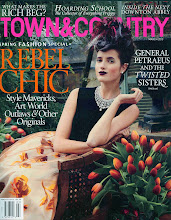 Photos courtesy of Monacelli Press
Photos courtesy of Monacelli PressScholar, designer, auction house appraiser, museum fellow, and historical aesthete. These are just a few of the esteemed titles that apply to interior designer Thomas Jayne, one of the most academically advanced and erudite interior designers of our time. In his new book, The Finest Rooms in America from Monacelli Press, written with Ann Walker, Jayne gives his take on what he deems to be the fifty rooms that are the most beautiful examples of American decoration today. Arranged chronologically, beginning with Mount Vernon and Monticello, important rooms are highlighted from the eighteenth and nineteenth centuries, as well as a selection from the twentieth and twenty-first centuries. Mixing diversity of periods and styles, the eclectic assortment reveals how people have lived in the past up to current day environs. Alas I could not show all 50, but this should give you a sense of the depth and breadth of Thomas Jayne's vast knowledge on historically important rooms across the US.
 A rarely seen angle of Albert Hadley's New York apartment with Robin's Egg blue wall framed in brass and graphic borders above upper and lower moldings.
A rarely seen angle of Albert Hadley's New York apartment with Robin's Egg blue wall framed in brass and graphic borders above upper and lower moldings. Casa Amesti, a Colonial adobe home in Monterrey, California. This is the beautiful blue and cream living room designed by the legendary Francis Elkins. It is one of the finest surviving examples of her work.
Casa Amesti, a Colonial adobe home in Monterrey, California. This is the beautiful blue and cream living room designed by the legendary Francis Elkins. It is one of the finest surviving examples of her work. The living room shown here is in Beauport, a house museum in Gloucester, Massachusetts. A colorful and inventive mix of historic styles and color combines Windsor Chairs and vivid painted trim. With over 40 rooms created by interior designer Henry Davis Sleeper in the mid 1900's, the home provides endless inspiration for interior designers.
The living room shown here is in Beauport, a house museum in Gloucester, Massachusetts. A colorful and inventive mix of historic styles and color combines Windsor Chairs and vivid painted trim. With over 40 rooms created by interior designer Henry Davis Sleeper in the mid 1900's, the home provides endless inspiration for interior designers.I asked Thomas about the book recently and he shared his insights with me:
Why a book about the finest rooms in America?
Considering all the books and magazines devoted to interior design, there are very few that firmly declare that a room is refined. Refinement and its estimation is, of course, subjective and stating personal opinion is risky. The value in this book, and the risk it takes, is that it starts a conversation about what are the finest rooms and that a fine room is a worthy goal.
How did you ever decide what to include? You have travelled extensively and seen so much.
The book illustrates a selection of fine rooms, beginning in the 18th century up to the present, starting with Thomas Jefferson ending with Albert Hadley. Virtually every style and type of rooms is present. There are comparable rooms that are not illustrated but I encourage readers to think about what makes a fine rooms and to make their own list (as a matter of fact, I am creating a website, www.thefinestrooms.com that will allow people to suggest their own finest rooms.)
Some of the rooms are surprising choices; they do not seem obviously fine. One room, a rustic but highly refined room of Mary Cooper’s in New Orleans was greeted by some of the people of taste that I consulted about the book with “are you nuts”? The room is furnished with modest examples of the decorative arts, but painted and arranged with much sophistication. The point is that refinement is not about expense.
What made these rooms catch your eye?
I found in writing the book that a fine room is usually focused on a work of art, object of beauty or sentiment and then arranged with great thought and care. The art does not have to be an expensive masterpiece-- it can be a work by an artist that is not famous, but it does have to resonate with the room’s owner. Same with objects—their significance to the owner comes through in looking at the room.
Does every room need to be comfortable?
To the degree that you want it to be -- if you aspire to make a room more than just utilitarian and consider its decoration an important element, it would be something to aspire towards.
What makes a room successful from a design standpoint?
A room is successful if the owner and its visitors want to be in it and that it works for its purpose. A living room where company is expected should be comfortable for a visit and the decoration must be pleasing.
What does every room need to be comfortable?
There is no single furnishing that makes every room comfortable. All comfortable rooms are appropriate for their purpose. The notion that every comfortable room requires a place to set cocktails is a fallacy.
What is your favorite decorative detail?
Paint -- the remarkable and transformative power of paint. The paint in every room in The Finest Rooms in America, is well considered and beautifully applied -- even the white ones. Paint is also about the texture and light it brings to a room.
If there were one place everyone could visit, what room would you recommend?
I would send every American to Monticello. It represents much that is paramount about American design and its philosophy
What is a favorite room abroad?
Can I answerer that favorite room in each country? The Pantheon in Rome, the Salon at Hotel de Soubise in Paris, The Throne Room of the Royal Palace in Madrid
If there was one historical fact you could impart about the history of design what would it be?
I encourage people to consider the value of design – just think how costly bad design always turns out to be. I often paraphrase Oscar Wilde who said beauty has no value unless it is realized in form – meaning we must pursue the higher ideals of beauty and try to achieve them in what we create.

























3 comments:
Thank you for posting the beautiful big pix of Frances Elkins living room. Do you know if its a period photo or was it shot for the book? It looks period...
A great interview with Mr Jayne! I can hardly wait to see his new book.
I believe the photo of Casa Amesti was taken by Fred Lyon in 1983 in conjunction with an article on Elkins in Connoisseur magazine. Elkins died in 1953. Her daughter Katherine Boyd helped Lyon stage the dining room for his shoot (see Lyon's dining room photo in Steve Salny's book on Elkins which shows the table set for a meal with Elkins's china and linens). I don't think photos of Casa Amesti appeared in the article. The sala at Casa Amesti looks about the same now except there is a sofa, loveseat and chair upholstered in a yellow print fabric that Elkins had used in the room in her lifetime. Mrs. Boyd made this change. Mr. Salny's book depicts the sala with these alternate furnishings (he used a circa 1998 Architectural Digest photo of the living room).
Post a Comment